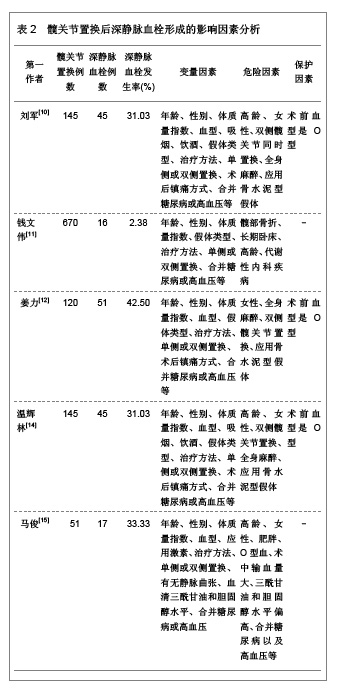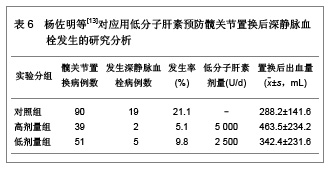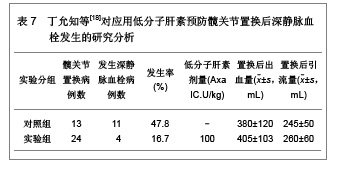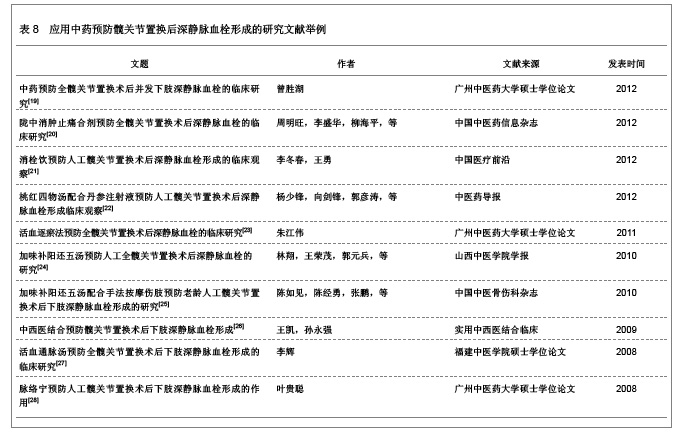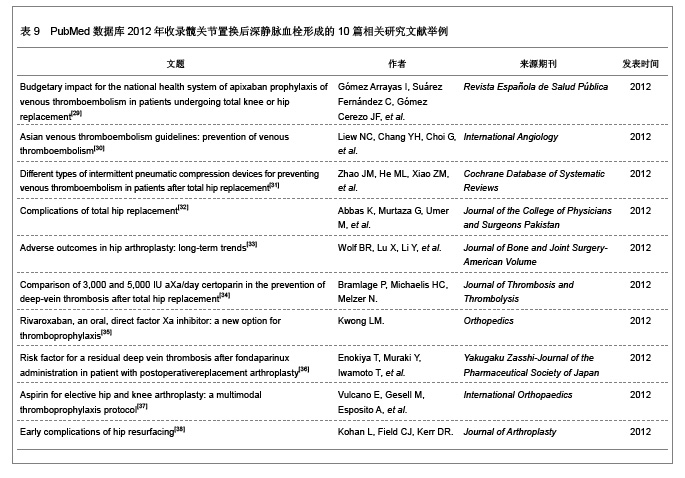| [1] Lonner JH, Frank J, McGuire K, et al. Postthrombotic syndrome after asymptomatic deep vein thrombosis following total knee and hip arthroplasty. Am J Orthop (Belle Mead NJ). 2006;35(10):469-472. [2] Clarke MT, Green JS, Harper WM, et al. Screening for deep-venous thrombosis after hip and knee replacement without prophylaxis. J Bone Joint Surg Br. 1997;79(5): 787-791. [3] Westrich GH, Sculco TP. Prophylaxis against venous thromboembolic disease: costs and controversy. J Bone Joint Surg Am. 2002;84-A(12):2306-2307. [4] 邱贵兴,杨庆铭,余楠生,等.低分子肝素预防髋、膝关节手术后下肢深静脉血栓形成的多中心研究[J].中华骨科杂志,2006,26(12): 819-822.[5] Esmon CT. Basic mechanisms and pathogenesis of venous thrombosis. Blood Rev. 2009;23(5):225-229. [6] 查振刚,臧学慧,姚平,等.全髋关节置换术后深静脉血栓形成的临床研究及危险因素分析[J].中华外科杂志,2005,43(8):511-512.[7] 张维蛟,王东生,孙红辉,等.老年患者全髋关节置换术后深静脉血栓的联合预防(附45例分析)[J].吉林医学,2008,29(19): 1647-1648.[8] 杨景武,史晓林.人工全髋关节置换术后下肢深静脉血栓形成原因的实验观察[J].中国临床康复,2005,9(42):164-166.[9] 中国知网.中国学术期刊总库[DB/OL].2012-12-2. https://www.cnki.net[10] 刘军,沈飞,黄际河.全髋关节置换术后深静脉血栓形成的危险因素分析[J].昆明医科大学学报,2012,33(7):84-87.[11] 钱文伟,翁习生,常晓,等.人工髋关节置换后深静脉血栓形成影响因素的回顾分析[J].中骨组织工程研究,2012,16(4):622-625.[12] 姜力.老年髋关节置换术后深静脉血栓形成的发生率及危险因素分析[J].医药论坛杂志,2011,32(16):17-19.[13] 杨佐明,刘晓明,戴士峰,等.低分子肝素预防人工全髋关节置换术后深静脉血栓疗效观察[J].中国修复重建外科杂志,2010,24(9): 1058-1061.[14] 温辉林,王友华,顾永强,等.全髋关节置换术后深静脉血栓形成的危险因素分析[J].江苏医药,2009,35(2):145-147.[15] 马俊,沈彬,杨静,等.人工全髋关节置换术后下肢深静脉血栓形成的危险因素分析[J].中国矫形外科杂志,2009,17(13):965-969.[16] 马骊,任凤霞,张林.全髋关节置换后血清炎性因子表达及深静脉血栓形成57例分析[J].中国组织工程研究与临床康复,2009, 13(4):771-773.[17] 李春杰,芦皓,文军,等.全髋关节置换者深静脉血栓形成早期血浆细胞因子及细胞间黏附分子的变化[J].中国组织工程研究与临床康复,2008,12(4):639-642.[18] 丁允知,刘晓钟.低分子肝素预防人工全髋关节置换术后下肢深静脉血栓形成的研究[J].海南医学,2008,19(10):82-83.[19] 曾胜湖.中药预防全髋关节置换术后并发下肢深静脉血栓的临床研究[D].广东:广州中医药大学,2012:1-45.[20] 周明旺,李盛华,柳海平,等.陇中消肿止痛合剂预防全髋关节置换术后深静脉血栓的临床研究[J].中国中医药信息杂志,2012, 19(3): 13-15. [21] 李冬春,王勇.消栓饮预防人工髋关节置换术后深静脉血栓形成的临床观察[J].中国医疗前沿,2012,7(4):41,54. [22] 杨少锋,向剑锋,郭彦涛,等.桃红四物汤配合丹参注射液预防人工髋关节置换术后深静脉血栓形成临床观察[J].中医药导报,2012, 18(9):28-30.[23] 朱江伟.活血逐瘀法预防全髋关节置换术后深静脉血栓的临床研究[D].广东:广州中医药大学,2011:1-42.[24] 林翔,王荣茂,郭元兵,等.加味补阳还五汤预防人工全髋关节置换术后深静脉血栓的研究[J].山西中医学院学报,2010,11(2):26- 27. [25] 陈如见,陈经勇,张鹏,等.加味补阳还五汤配合手法按摩伤肢预防老龄人工髋关节置换术后下肢深静脉血栓形成的研究[J].中国中医骨伤科杂志,2010,(1):29-31.[26] 王凯,孙永强.中西医结合预防髋关节置换术后下肢深静脉血栓形成[J].实用中西医结合临床,2009,9(2):33-34.[27] 李辉.活血通脉汤预防全髋关节置换术后下肢深静脉血栓形成的临床研究[D].福建:福建中医学院,2008:1-32. [28] 叶贵聪.脉络宁预防人工髋关节置换术后下肢深静脉血栓形成的作用[D].广东:广州中医药大学,2008:1-28.[29] Gómez Arrayas I, Suárez Fernández C, Gómez Cerezo JF, et al. Budgetary impact for the national health system of apixaban prophylaxis of venous thromboembolism in patients undergoing total knee or hip replacement. Rev Esp Salud Publica. 2012;86(6):601-612.[30] Liew NC, Chang YH, Choi G, et al. Asian venous thromboembolism guidelines: prevention of venous thromboembolism. Int Angiol. 2012;31(6):501-516.[31] Zhao JM, He ML, Xiao ZM, et al. Different types of intermittent pneumatic compression devices for preventing venous thromboembolism in patients after total hip replacement. Cochrane Database Syst Rev. 2012. [32] Abbas K, Murtaza G, Umer M, et al. Complications of total hip replacement. J Coll Physicians Surg Pak. 2012;22(9): 575-578. [33] Wolf BR, Lu X, Li Y, et al. Adverse outcomes in hip arthroplasty: long-term trends. J Bone Joint Surg Am. 2012; 94(14):e103. [34] Bramlage P, Michaelis HC, Melzer N. Comparison of 3,000 and 5,000 IU aXa/day certoparin in the prevention of deep-vein thrombosis after total hip replacement. Thromb J. 2012;10(1):10. [35] Kwong LM. Rivaroxaban, an oral, direct factor Xa inhibitor: a new option for thromboprophylaxis. Orthopedics. 2012;35(6): e932-8;discussion e939. [36] Enokiya T, Muraki Y, Iwamoto T, et al. Risk factor for a residual deep vein thrombosis after fondaparinux administration in patient with postoperativereplacement arthroplasty. Yakugaku Zasshi. 2012;132(5):683-687.[37] Vulcano E, Gesell M, Esposito A, et al. Aspirin for elective hip and knee arthroplasty: a multimodal thromboprophylaxis protocol. Int Orthop. 2012;36(10):1995-2002. [38] Kohan L, Field CJ, Kerr DR. Early complications of hip resurfacing. J Arthroplasty. 2012;27(6):997-1002. [39] 张玥,刘效敏,张玉冬.深静脉血栓形成患者血清TNF-α、IL-6、IL-10水平变化及意义[J].放射免疫学杂志,2007,20(1):13-14.[40] Salvati EA, Della Valle AG, Westrich GH, et al. The John Charnley Award: heritable thrombophilia and development of thromboembolic disease after total hip arthroplasty. Clin Orthop Relat Res. 2005;441:40-55. [41] Senaran H, Acaro?lu E, Ozdemir HM, et al. Enoxaparin and heparin comparison of deep vein thrombosis prophylaxis in total hip replacement patients. Arch Orthop Trauma Surg. 2006;126(1):1-5. [42] Berend KR, Lombardi AV Jr. Multimodal venous thromboembolic disease prevention for patients undergoing primary or revision total joint arthroplasty: the role of aspirin. Am J Orthop (Belle Mead NJ). 2006;35(1):24-29. [43] 孟华,姜玉新.孤立性小腿深静脉血栓的超声诊断[J].中国医学影像技术,2002,18(9):919-921.[44] 关振鹏,吕厚山,陈彦章,等.影响人工关节置换术后下肢深静脉血栓形成的临床风险因素分析[J].中华外科杂志,2005,43(20): 1317-1320.[45] 查长松,赵玉华.彩色多普勒血流显像诊断下肢深静脉血栓[J].中国医学影像学杂志,1999,7(1):45-47.[46] Cronan JJ, Dorfman GS, Scola FH, et al. Deep venous thrombosis: US assessment using vein compression. Radiology. 1987;162(1 Pt 1):191-194.[47] Baxter GM, McKechnie S, Duffy P. Colour Doppler ultrasound in deep venous thrombosis: a comparison with venography. Clin Radiol. 1990;42(1):32-36. [48] Perrier A. Diagnostic strategies of thrombo-embolic venous disease. Rev Prat. 2003;53(1):35-41.[49] 秦琍.彩超在下肢深静脉血栓诊治中的应用[J].江苏医药,2005, 31(11):867.[50] 沈洲,徐福祥,樊盛军,等.低分子肝素对于人工全髋关节置换术后下肢深静脉血栓形成的预防[J].中国现代医药杂志,2007,9(2): 74-76.[51] Warwick D, Friedman RJ, Agnelli G, et al. Insufficient duration of venous thromboembolism prophylaxis after total hip or knee replacement when compared with the time course of thromboembolic events: findings from the Global Orthopaedic Registry. J Bone Joint Surg Br. 2007;89(6):799-807. [52] 王琦,张先龙,沈骏,等.“低风险”人群初次人工关节置换术后的深静脉血栓[J].中华骨科杂志,2007,27(2):106-109.[53] Schindler OS, Dalziel R. Post-thrombotic syndrome after total hip or knee arthroplasty: incidence in patients with asymptomatic deep venous thrombosis. J Orthop Surg (Hong Kong). 2005;13(2):113-119. |
